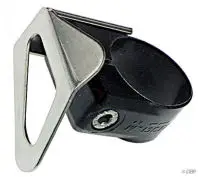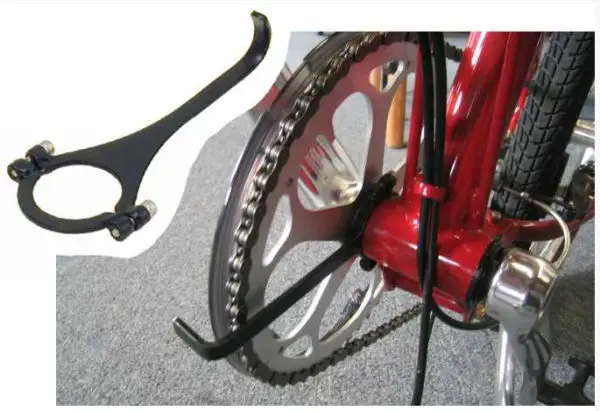
|

Bicycle chainwheels become doated in black gunk when in use, from oxidized metal particles embedded in chain lube. Yuck.
Several videos on the Internet show people picking up chains with their fingers to replace them on sprockets. Really, now! Humans are a tool-using species and there's usually no need to get chain schmutz on your hands or your clothing. Replacing the chain is usually easy, as shown in the video below. It is usually possible to replace the chain on the chainwheel without touching it, using a tool or a stick found by the side of the road, starting at the bottom of the chainwheel, and turning the crank backward. You hold the bicycle upright with one hand, and re-engage the chain using the other. You don't need an assistant, and you don't need to hold the rear wheel up off the ground, thanks to the miracle of freewheeling. (Well, yes, unless the bicycle has a fixed gear or coaster brake.)
The bicycle shown has a non-derailer drivetrain, and the chain was a bit slack, so I could keep the stick under the chain all the way around to the top. On a non-derailer bicycle, the chain probably won't come off if you can't get the stick in, but you'll have to remove the stick before the chain has come all the way up to the top of the chainwheel. On a bicycle with a front derailer, you also have to pull the stick out before it reaches the top. You may need to rest the pedal on your knee for a moment until you can grasp it with your hand and adjust the derailer so the chain will run backwards through it. On a bicycle with derailers, it may be easier to work from the left side, especially if the chain has come off to the left of the chainwheels.
If the chain has jammed at the rear wheel, it often can be released by rotating the wheel backwards so that tension on the lower run of chain pulls it out of the jam. Be careful not to pull so hard that you damage the rear derailer. In difficult cases, disconnecting the rear derailer from the frame so it hangs on the lower run of chain allows you to rotate the wheel backwards without risk of damage. You may also lever the chain out with a screwdriver. On a bicycle with a quick-release wheel, freeing the chain may be easiest if you remove the wheel, especially if the chain has jammed between the outermost sprocket and the dropout.
In case these tricks fail, carry a pair of gardening gloves or medical gloves in your on-road toolkit. I have only once had to help one cyclist whose chain was so jammed between spokes and sprocket that I had to remove the cassette to get it out. There was also a broken spoke, and I had to true the wheel as well as posible without this spoke to make the bicycle rideable.
If you do get grease on yourself, use a cleaning product that cuts grease, before a soap and water rinse. There are hand-cleaning products for mechanics which do the job.
![]()
![]()
It is fairly common for a bicycle chain to come off . Contributing to this problem can be:
There may be other factors too, I'm sure I haven't named them all. Occasionally a chain will come off even on a well-maintained bicycle.
![]()
![]()
A chain may come off to the inside or to the outside at the rear wheel; at the crankset, it may fall to the outside onto the bicycle's bottom-bracket shell, or to the outside, between the right crank and outer chainwheel. In either case, it may either hang loose or jam in place.
When the chain comes off, the pedals may spin forward freely, and or jam.
A chain which has fallen off may jam if it catches on a chainwheel. The chain may jam in a derailer, and may bend it. The chain also may jam if the derailer is misaligned with the sprocket on which the chain is resting -- when backpedaling or if the bicycle is rolled backward, or if a derailer has been shifted while the bicycle was not being pedaled: while coasting or while the bicycle was not moving.
Chain suck is one kind of chain jam: the chain is carried upward and jams between the right chainstay and inner chainwheel. Chain suck is most common with a small inner chainwheel, or when shifting to one, and on a mountain bike whose chain has become clogged with mud.
With chain suck, the pedals jam. The chain can become bent and can damage the right chainstay -- especially if it is of aluminum or carbon fiber.
Chain breakage was almost unknown until Shimano introduced 9-speed cassettes and narrower chain for them. The smooth shifting of a Hyperglide cassette encouraged cyclists to shift under power, sometimes bending the chain and pulling out a rivet pin. The problem is worse yet with a 10-, 11-, 12 speed cassette.
Because the rear derailer only tensions the chain lightly, the chain in a derailer system may skip forward over a rear sprocket. The usual causes are a worn chain on a new sprocket, or a chain with a bent or stiff link. On a bicycle without derailers, a worn chain adjusted for minimum slack will run roughly -- and inefficiently -- because the return run of the chain will forcibly pull the chain links onto the sprocket teeth. These problems are addressed at more length in the article about chain wear.
Your first line of defense against chain incidents on a derailer-equipped bicycle is to shift with care. It's become somewhat of a lost art with the advent of Hyperglide, but if you stay seated and pedal lightly when shifting, your feet will warn you that a shift isn't going well. Taking this care also will prevent damage, and will let you maintain control of the bicycle if the chain falls off. Spinning is more efficient and easier on the knees, too: low gears for climbing are preferable to macho "honking" up hills. Save standing for short accelerations and sprints when you don't have time to shift.
Shift down before starting, and once stopped, backpedal lightly to raise a pedal into the 10 o'clock position for starting. You should feel no resistance. If you do, a derailer is misaligned with the sprocket that holds the chain. Reduce force on the pedal and adjust the shifter(s) until the chain runs smoothly backward.
Well-adjusted derailers don't overshift beyond the limits of the cassette or chainwheels. Keeping the chain in good condition and replacing worn sprockets along with the chain avoid skipping.
![]()
![]()
Many modern cranks and chainwheels have a protruding pin to catch a chain which has fallen off to the outside. This helps to prevent the chain from jamming between the crank and chainwheel.
A chain deflector, such as the N-Gear Jump Stop Chain Guide (right) can prevent the chain from coming off the inner chainwheel.
A cyclocross ring (like a chainwheel without teeth -- you can make one by grinding the teeth off a worn chainwheel) helps to keep the chain on the chainwheel -- but is not possible at the inside if there is more than one chainwheel. An outside cyclocross ring also helps keep chain dirt off your clothing. It is preferably installed outboard of the normal position of the chainwheel -- using a triple-chainwheel bolt set if there are two chainwheels on the outer bolt circle of the crankset. A cyclocross ring and a chain guide. as shown below, are especially helpful on Bike Friday's folding bicycles, where the chain loses tension as the bicycle is folded.

![]()
![]()
 Chain jams at the rear wheel are avoided by careful adjustment of the rear derailer, good spacing between the right dropout and sprocket (see article on chainline) and use of a spoke protector plate behind the cassette or freewheel. A spoke protector plate is regarded as the height of uncool by racing coaches, but it can avoid spoke damage as well as chain jams.
Chain jams at the rear wheel are avoided by careful adjustment of the rear derailer, good spacing between the right dropout and sprocket (see article on chainline) and use of a spoke protector plate behind the cassette or freewheel. A spoke protector plate is regarded as the height of uncool by racing coaches, but it can avoid spoke damage as well as chain jams.
If the bicycle falls onto its right side, be careful to check whether the derailer hanger is bent inward -- a major cause of chain jams and of the rear derailer's catching in the spokes. Advice is here. Do not pull on the derailer, it is the hanger which is bent.
On a non-derailer drivetrain, your main line of defense other than possibly using cyclocross rings is to keep the chain correctly adjusted, with minimal slack. You will need to move back the rear wheel a couple of times as the chain elongates, before it is worn out.
![]()
![]()
![]()
Last Updated: by Harriet Fell